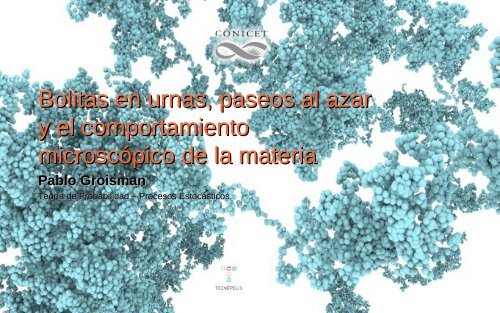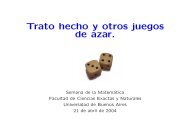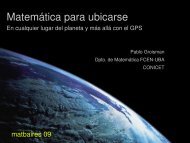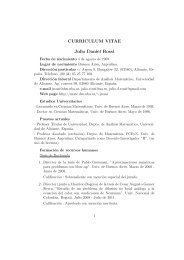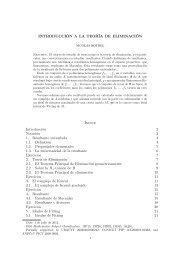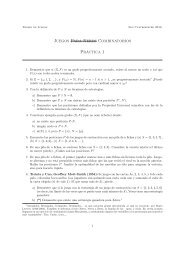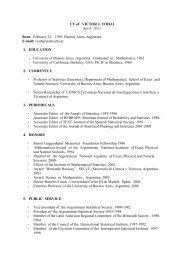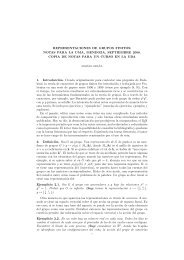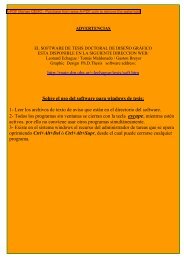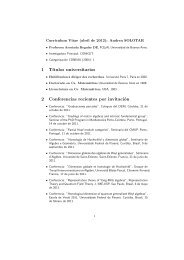Bolitas en urnas, paseos al azar y el comportamiento microscópico ...
Bolitas en urnas, paseos al azar y el comportamiento microscópico ...
Bolitas en urnas, paseos al azar y el comportamiento microscópico ...
Create successful ePaper yourself
Turn your PDF publications into a flip-book with our unique Google optimized e-Paper software.
<strong>Bolitas</strong> <strong>en</strong> <strong>urnas</strong>, <strong>paseos</strong> <strong>al</strong> <strong>azar</strong><br />
y <strong>el</strong> comportami<strong>en</strong>to<br />
<strong>microscópico</strong> de la materia<br />
Pablo Groisman<br />
Teoría de Probabilidad – Procesos Estocásticos.
Grupo de investigación <strong>en</strong> teoría de<br />
probabilidad y procesos estocásticos<br />
IMAS (UBA-CONICET)<br />
CONICET EN TECNÓPOLIS
<strong>Bolitas</strong> <strong>en</strong> <strong>urnas</strong><br />
CONICET EN TECNÓPOLIS
Dos <strong>urnas</strong> (A y B). En tot<strong>al</strong> hay 100 bolitas<br />
numeradas d<strong>el</strong> 1 <strong>al</strong> 100. Se <strong>el</strong>ige una bolita <strong>al</strong><br />
<strong>azar</strong> y se la cambia de urna. Se repite<br />
sucesivam<strong>en</strong>te<br />
CONICET EN TECNÓPOLIS
Nos interesa saber cuántas bolitas rojas<br />
hay <strong>en</strong> la urna A después de mucho<br />
tiempo y cómo se comporta esta<br />
cantidad.<br />
CONICET EN TECNÓPOLIS
CONICET EN TECNÓPOLIS<br />
Paseos <strong>al</strong> <strong>azar</strong>
Paseos <strong>al</strong> <strong>azar</strong><br />
CONICET EN TECNÓPOLIS
Paseos <strong>al</strong> <strong>azar</strong><br />
CONICET EN TECNÓPOLIS
Paseos <strong>al</strong> <strong>azar</strong><br />
CONICET EN TECNÓPOLIS
Paseos <strong>al</strong> <strong>azar</strong><br />
CONICET EN TECNÓPOLIS
Paseos <strong>al</strong> <strong>azar</strong><br />
CONICET EN TECNÓPOLIS
Urna de Ehr<strong>en</strong>fest (1907)<br />
Ludwig Boltzmann Paul Ehr<strong>en</strong>fest, su hijo y A. Einstein Tatiana Ehr<strong>en</strong>fest<br />
Urna de Ehr<strong>en</strong>fest: mod<strong>el</strong>o para explicar la<br />
termodinámica <strong>en</strong> base a la teoría cinética de<br />
la materia<br />
CONICET EN TECNÓPOLIS
CONICET EN TECNÓPOLIS
Equilibrio: cada bolita ti<strong>en</strong>e igu<strong>al</strong><br />
probabilidad de estar <strong>en</strong> cu<strong>al</strong>quiera de<br />
las dos <strong>urnas</strong><br />
CONICET EN TECNÓPOLIS
Reversibilidad vs. Recurr<strong>en</strong>cia<br />
CONICET EN TECNÓPOLIS
10.000 bolitas rojas (<strong>en</strong> re<strong>al</strong>idad hay<br />
602.214.150.000.000.000.000.000)<br />
Probab. de que estén todas <strong>en</strong> la misma caja:<br />
Tiempo medio de recurr<strong>en</strong>cia:<br />
años<br />
Edad d<strong>el</strong> Universo:<br />
Probab de que estén la mitad <strong>en</strong> cada caja:<br />
Tiempo medio de recurr<strong>en</strong>cia: 175seg ~ 3 min<br />
CONICET EN TECNÓPOLIS
Paseos <strong>al</strong> <strong>azar</strong> – Movimi<strong>en</strong>to Browniano<br />
Robert Brown (1827) Albert Einstein (1905) Jean Baptiste Perrin (1909)<br />
CONICET EN TECNÓPOLIS
1. C<strong>al</strong>cula <strong>el</strong> desplazami<strong>en</strong>to medio de las partículas<br />
2. D = 2RT/NF<br />
R = constante univers<strong>al</strong><br />
T = Temperatura<br />
Einstein (1905)<br />
N = Constante de avogadro (desconocida hasta <strong>el</strong> mom<strong>en</strong>to)<br />
F = Coefici<strong>en</strong>te de fricción (se puede c<strong>al</strong>cular).<br />
CONICET EN TECNÓPOLIS
Perrin (1908)<br />
Basado <strong>en</strong> la deducción de Einstein re<strong>al</strong>iza <strong>el</strong> experim<strong>en</strong>to y<br />
determina <strong>el</strong> número de Avogadro (y se gana <strong>el</strong> premio Nob<strong>el</strong>!)<br />
CONICET EN TECNÓPOLIS
¿y qué hacemos los matemáticos?<br />
Paseos <strong>al</strong> <strong>azar</strong> <strong>en</strong> medios <strong>al</strong>eatorios<br />
CONICET EN TECNÓPOLIS
¿y qué hacemos los matemáticos?<br />
Nos interesa saber hasta qué punto<br />
es cierto que los <strong>paseos</strong> <strong>al</strong> <strong>azar</strong><br />
converg<strong>en</strong> <strong>al</strong> Movimi<strong>en</strong>to Browniano<br />
CONICET EN TECNÓPOLIS
CONICET EN TECNÓPOLIS<br />
Cluster de percolación<br />
Berger-Biskup (2005)<br />
Matthieu-Piatninski (2005)
CONICET EN TECNÓPOLIS<br />
Medios no <strong>el</strong>ípticos<br />
Berger-Deusch<strong>el</strong> (2011)
CONICET EN TECNÓPOLIS<br />
Grafo D<strong>el</strong>aunay-Poisson<br />
Ferrari-Grisi-Groisman (2011)
CONICET EN TECNÓPOLIS
CONICET EN TECNÓPOLIS
CONICET EN TECNÓPOLIS<br />
Muchas gracias
Consejo Nacion<strong>al</strong> de Investigaciones Ci<strong>en</strong>tíficas Y Técnicas<br />
Av. Rivadavia 1917 C1033aaj República Arg<strong>en</strong>tina T. + 54 115983 1420


